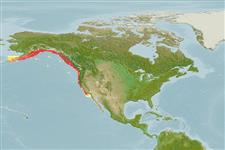>
Perciformes/Scorpaenoidei (Scorpionfishes) >
Sebastidae (Rockfishes, rockcods and thornyheads) > Sebastinae
Etymology: Sebastes: Greek, sebastes = august, venerable (Ref. 45335); flavidus: From the Latin flavidus, meaning 'yellow' (Ref. 27436).
More on author: Ayres.
Environment: milieu / climate zone / rango de profundidad / distribution range
Ecología
marino asociado a arrecife; rango de profundidad 0 - 549 m (Ref. 6793), usually 24 - 46 m (Ref. 2850). Temperate; 62°N - 32°N, 167°W - 117°W
Northeast Pacific: Unalaska Island, Alaska to San Diego, California, USA.
Length at first maturity / Tamaño / Peso / Age
Madurez: Lm 36.0, range 27 - 42 cm
Max length : 66.0 cm TL macho / no sexado; (Ref. 4925); peso máximo publicado: 2.5 kg (Ref. 40637); edad máxima reportada: 64 años (Ref. 39247)
Short description
Claves de identificación | Morfología | Morfometría
Espinas dorsales (total) : 13; Radios blandos dorsales (total) : 14 - 16; Espinas anales: 3; Radios blandos anales: 7 - 9. Head spines weak - nasals present, preocular and parietal spines usually absent, supraocular, postocular, tympanic, coronal and nuchal spines absent (Ref. 27437). May have a prominent symphyseal knob; posterior edge of anal fin vertical (Ref. 27436). Caudal fin nearly truncate but slightly forked (Ref. 6885). Olive green to greenish brown with some light mottling dorsally, light ventrally; fins yellowish green, ventral fins often tinged in orange (Ref. 27436).
Body shape (shape guide): fusiform / normal.
Form schools in open water along steeply sloping shores or above rocky reefs; also holes up amid cracks and crevices of the sea floor (Ref. 27436). Juveniles found around floats and pilings (Ref. 27436). Feed on pelagic crustaceans, fishes and squids (Ref. 6885). Viviparous (Ref. 34817). Filleted, then sold fresh or frozen, with other rockfishes (Ref. 27436).
Clemens, W.A. and G.V. Wilby, 1961. Fishes of the Pacific coast of Canada. 2nd ed. Fish. Res. Bd. Canada Bull. (68):443 p. (Ref. 4925)
IUCN Red List Status (Ref. 130435: Version 2025-1)
Threat to humans
Harmless
Human uses
Pesquerías: comercial; pesca deportiva: si; Acuario: Acuarios públicos
Herramientas
Special reports
Download XML
Fuentes de Internet
Estimates based on models
Preferred temperature (Referencia
123201): 4.2 - 11.4, mean 7.5 °C (based on 44 cells).
Phylogenetic diversity index (Referencia
82804): PD
50 = 0.5000 [Uniqueness, from 0.5 = low to 2.0 = high].
Bayesian length-weight: a=0.01000 (0.00495 - 0.02022), b=3.09 (2.92 - 3.26), in cm total length, based on LWR estimates for this Genus-body shape (Ref.
93245).
Nivel trófico (Referencia
69278): 4.2 ±0.6 se; based on diet studies.
Resiliencia (Referencia
120179): Bajo, población duplicada en un tiempo mínimo de 4.5-14 años (K=0.16; tm=6-7; tmax=64).
Prior r = 0.26, 95% CL = 0.17 - 0.40, Based on 1 full stock assessment.
Fishing Vulnerability (Ref.
59153): High vulnerability (56 of 100).
🛈
Climate Vulnerability (Ref.
125649): Low to moderate vulnerability (28 of 100).
🛈
Nutrients (Ref.
124155): Calcium = 6.46 [2.45, 19.19] mg/100g; Iron = 0.123 [0.048, 0.292] mg/100g; Protein = 19 [18, 20] %; Omega3 = 0.815 [0.305, 2.162] g/100g; Selenium = 28.4 [10.2, 86.7] μg/100g; VitaminA = 74.9 [24.9, 241.2] μg/100g; Zinc = 0.301 [0.155, 0.544] mg/100g (wet weight); based on
nutrient studies.
